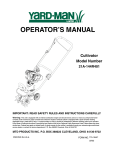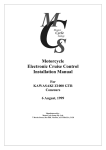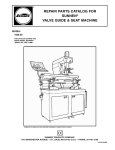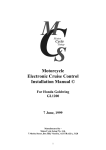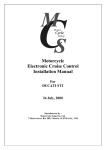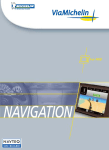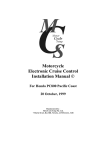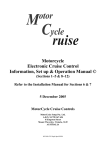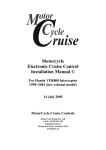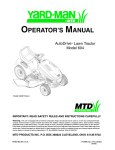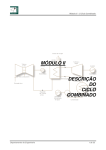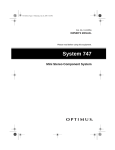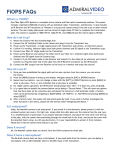Download Motorcycle Electronic Cruise Control Installation Manual ©
Transcript
Motorcycle Electronic Cruise Control Installation Manual © For BMW K1100 RS/RT/LT ABS 2 5 November, 1999 Manufactured by MotorCycle Setup Pty. Ltd. 7 Moritz Street, Box Hill, Victoria, AUSTRALIA, 3128 BMW K1100 RS/RT/LT ABS 2 models © MotorCycle Setup Pty. Ltd. Electronic Cruise Control Installation Manual © To suit BMW K1100RS/RT/LT with ABS 2 anti lock brakes Note: This cruise control kit will not fit earlier bikes with ABS 1 anti lock brakes. Your electronic cruise control has been adapted from an Australian designed, automotive cruise control specifically to suit your motorcycle. Months of testing have resulted in changes to the electronic circuitry to deliver safe, reliable operation on the motorcycle models listed above. It is essential that you install the correct kit to your motorcycle and follow the installation instructions precisely so that electrical interference does not cause the unit to behave erratically or be rendered inoperative. Your cruise control is fitted with a new ‘Cruise Safe’ safety cut out. If the cruise control should malfunction, either due to electrical interference or component failure, applying the brakes enough to turn the brake light on will instantly cut power to the cruise control actuator (servo). Releasing the brakes will restore power to the actuator. If the malfunction is still occurring, the only way to turn the cruise control off completely is to turn the cruise control power switch off, or the bike ignition switch. The bike ‘kill’ switch will stop the engine, but it may NOT turn the cruise control off. This device is fail safe in all respects except one. The brake light switches must be operative for this device to work. See the section on Safety Issues & Features for more information. WARNING: - CHECK THAT BOTH BRAKE LIGHT SWITCHES WORK PROPERLY AND ARE ADJUSTED CORRECTLY EVERY TIME BEFORE RIDING THE MOTORCYCLE. IF EITHER SWITCH IS NOT WORKING, TURN THE CRUISE CONTROL OFF, AND DO NOT USE IT. WE STRONGLY RECOMMEND AGAINST FITTING OFF-THE-SHELF MOTOR CAR CRUISE CONTROLS TO ANY MOTORCYCLE! If, after reading these instructions, you feel you are not competent to install this kit, we strongly urge you to seek the assistance of one of our authorised dealers and installers. Please phone or email us to obtain the name of your nearest outlet. A list will also be available soon on our ‘web page’ http://www.mccruise.com. CONTENTS 1. INTRODUCTION 2. WARNINGS, CAUTIONS AND NOTES 3. TOOLS REQUIRED 4. PARTS LIST 5. OVERVIEW OF CRUISE CONTROL OPERATION 6. PREPARING THE BIKE FOR CRUISE CONTROL INSTALLATION 7. INSTALLATION 8. DIAGNOSTIC MODE OPERATION 9. MANUAL ADJUSTMENTS TO THE BRAKE PEDAL AND FRONT BRAKE LEVER 10.OPERATING INSTRUCTIONS 11.SAFETY ISSUES & FEATURES 12. ROAD TEST AND ADJUSTMENTS 13. TROUBLE SHOOTING, TESTING & SELF DIAGNOSTICS 14.RIDING TIPS 2 BMW K1100 RS/RT/LT ABS 2 models © 1. INTRODUCTION Congratulations, you have purchased one of the most advanced cruise control systems in the world - and the first after-market electronic cruise control kit adapted to motorcycles. Your new cruise control has more operating features than many units costing much more. All functions are microprocessor controlled, which reduces the complexity of installation. Before installing your cruise control, take the time to read and understand each installation step in this manual. Several steps are dependent on others, so it is important know where and how each component is to be mounted before installation commences. Your kit has been designed for a specific motorcycle. Even if you have installed kits before, take note of where and how components should be installed - particularly the wiring harness layout and connections. 2. WARNINGS, CAUTIONS and NOTES This manual contains several cautions, warnings and notes, which are prominently displayed. The convention used is: A warning applies whenever injury could result from ignoring the warning; A caution applies whenever damage to the bike or cruise control could result from ignoring the caution; and A note applies where other aspects should be considered before any action to do with installation is undertaken. EXAMPLES: WARNING: Always ensure the bike is properly supported on the side or centre stand and cannot accidentally fall off either stand. CAUTION: Before drilling any holes, make sure there are no components that may be damaged on the other side of the surface being drilled. Double check for any wiring harness which might be easily damaged by a drill bit. NOTE: Lay the wiring harness in place and connect the components before cable tying the harness in place. 3. • • • • • • 4. TOOLS REQUIRED Standard metric socket and spanner set ; Phillips head screwdriver; Flat blade screwdriver; Long nose pliers; Metric Allen key set – preferably with a ‘ball end’; Low or medium strength thread lock compound such as Loctite 243 or 222; PARTS LIST Check that all components depicted in the parts list at the rear of this manual are included in the cruise control kit. Please phone your dealer or (03) 9808 2804 or 0411 457 147 within Australia, international (61 3) 9808 2804 or fax (61 3) 9808 2445 for advice, if any parts are missing; 3 BMW K1100 RS/RT/LT ABS 2 models © 5. OVERVIEW OF CRUISE CONTROL OPERATION The principles behind your cruise control's operation are very simple: • The computer continuously monitors the frequency of electrical pulses generated by magnets passing the sensor; • When the SET key on the switch is pressed the computer stores the pulse frequency at the time in memory and then continuously adjusts the vacuum actuator, which controls the throttle to maintain the pulse frequency at the same figure to which it was set. If the frequency drops below the set frequency, the computer applies more throttle. If the frequency is above the set frequency, the computer turns the throttle off. The key is that the computer monitors and reacts to changes very quickly and smoothly so that the speed effectively remains nearly constant. There are six major components in your kit: the computer, the vacuum actuator, the cable interface unit, the speed sensor, the switch and the loom. The functions of each are described below: • • • • • • the computer - monitors road speed, adjusts the throttle by controlling the vacuum actuator, monitors the switch and brake system for instructions from these components; the vacuum actuator - controls the throttle by pulling or releasing a cable which attaches to the throttle bodies via the cable interface unit (CIU); the CIU - translates the motion from the throttle grip and the vacuum actuator to the throttle bodies via a new cable supplied in the kit; the speed sensor - generates electrical pulses when the bike is in motion; the switch - sends instructions from the rider to the computer; and the electrical loom - which connects the switch, the computer, the vacuum actuator, the sensor and the brake system. The cable interface unit is a new component developed and patented by MotorCycle Setup and is the key to safe cruise control operation on motorcycles. An understanding of how it works should help you avoid making mistakes during installation. The following diagrams show the basic assembly procedure and operating principles of the cruise control Cable Interface Unit (CIU). The actual entry points of cables and the direction of rotation may differ depending on the model of the motor cycle, but the principles involved remain the same. Specific assembly instructions are provided later within this manual. In order to improve the clarity of the diagrams, the multiple holes in the carburettor and throttle spools have been omitted, with only the actual hole used for the cable nipple being shown. 4 BMW K1100 RS/RT/LT ABS 2 models © 1st step. The actuator spool is installed in the CIU housing with the actuator cable. The actuator spool is rotated to fully extend the cable. Actuator cable CIU housing Actuator spool Bush 2nd step. The carburettor cable and spool are installed and the other end of the carburettor cable is attached to the carburettors. Roll pin in carburettor spool Carburettor spool Note the position of the roll pin. It is nearly contacting the end of the groove in the actuator spool. The free play in the carburettor cable must be adjusted so that the cable outer can be pulled out 2 ~ 3mm before the carburettors start to open. This ensures that the cruise control cannot prevent the carburettors returning to idle. If more free play is allowed the response of the cruise control is compromised. Carburettor cable 2 ~ 3 mm This adjustment of free play is usually performed after final assembly of the CIU is completed and the CIU is in its final location. This is because flexing the cable does effect the free play. It is shown at this stage in these diagrams to improve clarity. After this adjustment is performed, the carburettor cable adjustment MUST NOT BE MOVED. All future adjustments of free play in the throttle must be performed on the throttle cable from the throttle grip. If incorrect free play in this cable is suspected due to inconsistent cruise operation or because of inconsistent idle speed, the adjusters on the throttle cable from the hand grip must be backed all the way off to give as much free play as possible. If this does not result in AT LEAST 5mm of free play in the throttle cable, the throttle cable must be removed from the hand grip or CIU before adjustment of the carburettor cable is attempted. This is crucial because the amount of free play in the throttle cable also effects the apparent free play in the carburettor cable. 5 BMW K1100 RS/RT/LT ABS 2 models © 3rd step The throttle cable and spool are installed. Note that the throttle spool and the actuator spool both have identical grooves in them. These grooves engage the roll pin in the carburettor spool (the centre spool). Throttle grip cable Throttle spool Normally the end cap and retaining nut would be installed at this point. These items are not shown in order to improve clarity. Normal throttle operation During normal operation of the throttle, the throttle cable is pulled by twisting the throttle grip. This pulls on the throttle spool and rotates it. The end of the groove contacts the roll pin in the carburettor spool, and the carburettor spool rotates, pulling the carburettor cable and opening the carburettors. Throttle grip is twisted pulling cable Roll pin in carburettor spool is pulled around by the end of the groove in the throttle spool Carburettor cable opens carburettors Actuator spool does not move Because the roll pin is free to move in the groove in the actuator spool, this spool does not move. This reduces friction in the throttle system and prevents any possibility of jamming due to cables buckling when being pushed. Cruise operation During cruise operation the actuator cable pulls the actuator spool and rotates it. The end of the groove contacts the roll pin in the carburettor spool, rotating the spool and pulling the carburettor cable. Actuator cable is pulled by actuator Throttle spool does not move If the throttle grip is twisted enough for Carburettor cable opens carburettors the groove in the throttle spool to contact the roll pin, then the cruise control is over ridden by the rider. When the throttle is released, the cruise control will resume control, unless it has been disengaged by brake operation or if the motor cycle exceeds the current set speed by 150% such as during an overtaking manoeuvre. The cruise will also disengage if the speed drops to 75% of set speed such as when riding up hill. This is unlikely to occur on large capacity motorcycles. 6 6. BMW K1100 RS/RT/LT ABS 2 models © PREPARING THE BIKE FOR CRUISE CONTROL INSTALLATION. Remove the following components from the motorcycle • • • • • • The right and left side covers; The fuel tank; The left engine protection bar (if fitted); The left side fairing lower panel; The rear half of the front mudguard; Disconnect the throttle cable from the throttle bodies. The following instructions may be used to remove the components. Side covers. K1100LT Pull the side covers off at the rear. Release the plug in the centre at the rear of the fuel tank. Release the clip at the centre near the bottom of the cover. Pull the cover to the rear to disengage it from the fairing. K1100RS Pull the side covers outwards of three mounting clips, one at the rear, one in the centre bottom and one at the front. Fuel tank. Remove the two clips at the left and right rear corners of the fuel tank. This is easiest with long nose pliers. Disconnect the plug for the fuel pump and fuel level sensor. Trace the wire that comes out under the rear of the fuel tank to the right side of the bike. The plug is a rounded plug with two latches on it. Pull out the latches and disconnect the plug. Lift up the rear of the tank, then pull the tank towards the rear of the bike to disengage the front mount. Lift the tank up and off the bike. There is enough length in the fuel hoses to sit the tank next to the bike on a chair or similar stand. Alternatively, the fuel hoses may be disconnected to allow complete removal of the tank. Disconnect the front hose off at the tank end, and the rear hose at the fuel rail on the cylinder head. Left engine-protection bar. Pull out the plastic plug at the top of the crash bar. Undo the 13mm nut inside the bar with a socket and extension. Undo the two 13mm nuts at the bottom of the crash bar. Remove the crash bar. 7 BMW K1100 RS/RT/LT ABS 2 models © Left side faring lower panel. K1100LT Remove screw near bottom of the inner panel (black fill panel between the fairing, fuel tank and engine). Remove two screws under latch for radio bin cover. Remove panel and disconnect fuel gauge wires. Remove the radio (if fitted) as follows. There are three small holes (about 3mm dia) each above, below and to the left of the radio. Place a small flat screwdriver in the holes while gently pulling up on the radio. Twist the screwdriver to release the latches. Pull the radio out. Remove the two screws at the top front edge of the radio box and lift out the box. Undo the three screws holding the fairing upper and lower together at the join. Remove the fill panel between the faring and the fuel tank. Remove the clip near the front top edge of the fairing panel attaching the upper fairing to the lower panel at the join. Remove the screw at the rear edge of the lower side panel about half way up the panel. Remove the screw at the bottom rear of the lower side panel. Remove the two screws at the bottom front of the lower side panel Remove the four screws on the front inner edge securing the lower side panel to the radiator surround. Lift the panel off. K1100RS Remove the three screws holding the inner panel (fill panel between the fuel tank and the fairing) to the fairing, one at the bottom and two at the top. Lift the panel off. Remove the belly pan by loosening the four screws on each side securing the belly pan to the side panels, and the two screws under the belly pan at the rear. Loosen and remove the four screws at the join of the lower panel and the top half of the fairing accessible from inside the fairing. Loosen and remove the three screws securing the small inner panel to the radiator surround. The top, larger screw also holds the lower fairing panel. Loosen the bolt holding the panel at the lower rear corner, above the cylinder head. Loosen and remove the single long screw at the top front edge of the fairing panel. This screw runs up into the fairing. Remove the side panel. 8 BMW K1100 RS/RT/LT ABS 2 models © Front mudguard rear half. K1100LT Undo the socket head screw below the brake fluid line where the line enters the mudguard area at the fork brace. Loosen (don’t remove) the two screws, one each side, securing the mudguard to the fork leg. Gently pull the lower edge of the guard out and release the velcro fastening at the bottom edge of the guard. Remove the rear half of the mudguard. K1100RS Loosen and remove the screw in the top of the plastic cover between the fork legs, then remove the cover. Loosen the two bolts, one each side, holding the mudguard to the fork legs. It is not necessary to remove these bolts. Loosen and remove the bolt at the top of the mudguard, securing it to the fork brace. Remove the rear half of the mudguard. Disconnecting the throttle cable. Back off the adjuster at the throttle grip to give as much free play as possible. Remove the throttle cable from the throttle bodies. The cable outer can be pulled out of the fitting at the throttle bodies, the nipple can be removed from the spindle while the throttle is held full open. Pull the cable out of the hole in the moulded rubber divider if it is threaded through it. This may only apply to the RS models not the LT. Lubricating the throttle grip and cable. While this is not essential maintenance, we have found the correct lubrication of the grip and cables enhances the ‘feel’ of the throttle and the longevity of the cables. This may be difficult to do on bikes fitted with heated grips (we have not attempted this on a bike fitted with heated grips). BMW also do not generally recommend lubricating the cables on the bikes as they are Teflon lined. We have found dramatic improvements in throttle action of other motorcycles also equipped with Teflon lined cables, and the cables supplied in the cruise kit are also Teflon lined. We supply all our kits with the cables pre-lubricated with light oil. Oiling the cables also helps prevent corrosion of the cable itself, thus enhancing he life of the cable. The throttle grip can be lubricated with engine oil or a oil grease mixture in the handle bar under the grip. If grease is used apply a THIN smear of grease to one side of the bra only and then a little oil. Spin the grip on the bar to mix and spread the grease and oil. 9 BMW K1100 RS/RT/LT ABS 2 models © Oil the cable with 6 drops of light oil, NEVER USE ENGINE OIL, sewing machine oil is ideal. 7. INSTALLATION. Installing the carburettor cable. Locate the new cable in the kit. Run the first lock nut off the adjuster and apply a drop of LOW or MEDIUM strength thread locker, such as Loctite 242 or 243, to the last few threads on the adjuster. Run the second lock nut all the way up the adjuster and apply a drop of thread locker to the threads just below the nut. Feed the cable through the hole in the moulded rubber divider if it was through the hole. This may only apply to RS models, not LT. Insert the cylindrical nipple on the new cable supplied in the kit into the throttle spindle. Place the adjuster in the cable receptacle on the throttle bodies and run the nut back onto the adjuster until the end of the adjuster is level with the outside face of the bottom nut. At most only one thread should be visible past the bottom nut. Run the top nut down and tighten GENTLY. The adjuster is made of brass and will break if the nuts are over tightened. Installing the CIU mount. Loosen and remove the front bolt that holds the fuel rail to the cylinder head. Place the CIU mount bracket on the bolt, making sure that the flat washer is still on the bolt under the head of the bolt. Place a drop of threadlocker on the bolt and put it back on the cylinder head. 10 BMW K1100 RS/RT/LT ABS 2 models © While tightening the bolt, ensure that the bracket does NOT make contact with the fuel rail or the fuel rail mounting bracket at all. Gently tighten the bolt. Check that there is at least 3mm clearance between the bracket and the fuel rail where the bracket runs past the rail. If not, bend the bracket until there is enough clearance. Installing the computer. Cut the foam mounting block to length to fit the area above the ABS actuator so that it nestles between the frame tube, the coolant bottle and the fuel injection computer. Use a sharp kitchen knife as a utility knife does not usually do a clean cut on this foam. Insert the computer into the foam block and position the block on top of the ABS unit with the connector on the computer facing out. Installing the wiring loom. The loom has three legs. Computer connection. The short leg with the 12 pin plug connects to the computer. The latch on the plug faces down. Connect the loom to the computer. Route the middle length leg with the brake, power and actuator connections to the right side of the bike across the front of the cruise control computer. The loom comes out just below the frame rail on the right side of the bike. 11 BMW K1100 RS/RT/LT ABS 2 models © Brake sensing and power connection. Locate the connector for the rear brake light switch. This plug is a black two pin plug near the rear brake fluid reservoir, along with some other connectors. One end has one yellow wire and one green wire with a black trace. The other end has one green wire with a black trace and one grey wire with a green trace. Disconnect this plug and connect them to the matching plugs on the cruise loom with the green and grey bridge wires. These plugs also have two brown wires and one orange wire running back into the loom. Route the red/black/white actuator wires towards the back of the bike for later connection to the actuator. Route the long leg forward past the fuse box inside the frame tubes, and out in front of the frame cross brace. Earth (ground) connection. Undo the earth (ground) bolt on the frame about 125mm (5”) behind the steering head. Place the green earth connector on this bolt and re-install the bolt. Clutch/neutral sensing connection. Locate the clutch switch connector. This may be difficult to find. It is a plug of the same design as the rear brake switch connector. It has two yellow wires in one end, that run to the clutch switch on the clutch lever, and one black wire with a green trace, and one green wire with a black trace. It will be somewhere in the jumble of connectors in the area under the earth (ground) bolt. It may be necessary to trace the wire back from the clutch switch. When you find it, disconnect the plug and connect them to the matching plugs on the cruise loom with the green and black bridge wires. One of these plugs also has one purple wire running back into the loom. 12 BMW K1100 RS/RT/LT ABS 2 models © Speed sensor connection. Route the remaining long wire forward through the frame to the brake fluid line for the front brakes. Route the wire down the brake hose to the front mudguard (fender). Route the wire across to the right fork leg, down the back of the fork leg, inside the top brake calliper mount. Draw the wire through between the fork leg and the calliper just above the bottom calliper mount, then back between the mount and the calliper. Mounting the speed sensor. Attach the wires to the speed sensor, it doesn’t matter which wire goes to which terminal. Remove the bottom calliper mount bolt, place the sensor bracket on the bolt, under the flat washer, then replace the bolt and tighten. Cable tie the sensor wire to the fork leg just above the bottom calliper mount, just above the top calliper mount and above the mudguard (fender) mount. On the K1100LT the brake hose is routed though the slots in the mudguard. In this case the wire can be cable tied to the brake hose instead of the top cable tie on the fork leg. Cable tie the wire to the brake hose in at least three places. 13 BMW K1100 RS/RT/LT ABS 2 models © Installing the magnets. Insert the magnets into the heads of three of the brake disc mounting bolts. If the bike has ‘Torx’ heads of the bolts holding the disc on, the magnets should be a neat fit in the heads of the bolts. If the bike has hex heads on the bolts, they will be a slightly loose fit. If desired a little silicone sealant can be placed in the bolt head before the magnet is inserted to ensure that they do not move. The magnets must be in each alternate bolt (evenly spaced around the disc wheel) and must have the same pole facing outwards. It does not matter which pole, as long as they are both the same. This can be achieved as follows. Attach the magnets to each other. Place one of the magnets in one of the disc mounting bolts. Slide the second and third magnet off the one in the bolt and, without rotating the magnets, place the next magnet in the second bolt head around the disk in either direction. Repeat the procedure leaving one magnet in the bolt head. Move in the same direction as before to the next bolt head, equidistant between the two magnets already installed. Ensure you do NOT rotate the magnet so that the same magnet face on all magnets, points outwards. Installing the actuator. Place a rag over the large casting that holds the footrests to protect the paint on the actuator covers during assembly. Remove the top cover on the actuator by removing the four screws in the top cover and removing the bracket and cover. Note that the three screws in the bracket are longer than the one screw in the cover. Remove the grommet from the hole in the cover and place it over the actuator wires. Thread the wires to the rear of the bike behind the frame tubes then through the large hole in the cover and connect them to the three wires on the actuator. Place the cover over the actuator while making sure that the actuator wire connectors remain between the top of the actuator and the cover. There is enough depth inside the cover for the connectors. 14 BMW K1100 RS/RT/LT ABS 2 models © Insert the short screw in the hole in the cover that will not mount the bracket. Do not tighten the screw yet. Place the bracket on the actuator and insert and tighten the other three longer screws. Tighten the shorter screw. If desired, tape may be placed on the frame tube to prevent the bracket or hose clamps scratching the paint. Position the actuator bracket on the diagonal frame tube that runs up to the rear from the swing arm pivot. The top of the bracket should be about 70mm (2 1/2”) down from the join with the top frame tube. Undo the hose clamps and thread them through the hole in the mounting bracket and rejoin them and tighten them while setting the final position for the actuator. The actuator should be nearly touching the bottom of the coolant overflow bottle. The ends of the hose clamps may be cut off if desired with side cutters. Looking down from above onto the actuator, it may be pointing outwards slightly at the front. Twist the actuator inwards to bend the mounting bracket until the actuator is parallel to the side of the bike. Thread the actuator cable to the left side of the bike through the gap behind the air filter housing and above the clutch bell housing. Installing the vacuum hose. Thread the long end of the vacuum hose through the grommet on the actuator wires. Push the end of the hose onto the hose barb that is visible through the hole in the actuator cover. Run the grommet down the hose and wire and insert into the hole in the cover. Route the hose forward behind the frame tubes, then across to the left side of the bike with the actuator cable. 15 BMW K1100 RS/RT/LT ABS 2 models © Pull the rubber cap off one of the throttle body balance ports and push the short end of the hose onto the port. Check that the black end of the valve in the hose is facing the engine and the white end is facing the actuator. Installing the throttle cable retainer. Screw the cable adjuster all the way out of the housing at the throttle grip. Place the retainer over the adjuster and screw the adjuster all the way back in. Installing the CIU. Route the actuator cable forward along the top of the fuel rail and through the moulded rubber divider at the same point as the fuel rail. Disassemble the CIU noting the location of all the components. If you are unclear about where the parts go, there is a drawing in the parts list at the back of the instructions showing the assembly order. Bend up the throttle cable retainer so that it is perpendicular to the side of the CIU. Insert the end of the cable into the hole in the CIU body with the lock screw. Push the cable in all the way until it is seated against the shoulder inside the hole and gently tighten the lock screw. 16 BMW K1100 RS/RT/LT ABS 2 models © Place the ball nipple on the actuator cable in the hole in the actuator spool and insert the actuator spool into the CIU with the groove facing out. Rotate the spool clockwise to fully extend the cable. Screw the adjuster on the carburettor spool all the way into the threaded hole in the CIU. Insert the nipple on the carburettor cable into the marked hole in the carburettor spool (the spool with the roll pin) and place the carburettor spool in the CIU with the shoulder side in and the marked side out. Make sure that the roll pin is engaged in the groove in the actuator spool and that the actuator cable is still fully extended (rotated all the way clockwise). Insert the bush through the two spools. Place a stack of five of the 8mm flat washers on the end of the bikes throttle cable. Insert the throttle cable into the remaining hole in the CIU. 17 BMW K1100 RS/RT/LT ABS 2 models © Insert the nipple into the marked hole in the throttle spool and place the spool on the bush in the CIU. Ensure that the roll pin on the carburettor spool is engaged in the groove in the throttle spool. Place the flat washer on the M5 x 45 bolt and insert the bolt into the CIU end cap. Place a drop of thread locker on the end of the bolt. Insert the bolt into the CIU and into the CIU mounting bracket. Position the CIU so that the cables are in their most relaxed position and tighten the bolt GENTLY. Adjusting the carburettor cable. Screw out the adjuster on the carburettor cable at the CIU until there is 1~3mm (1/16”~1/8”) free play in the cable. This can be checked by pulling the cable outer out of the adjuster. There should be 1~3mm of movement before the throttles start to move. Gently lock up the adjuster. REMEMBER! The adjuster is brass. Over tightening it will break the adjuster. NOTE:- This adjustment sets the free play between the cruise control actuator and the throttles. Free play adjustments in the hand grip must NEVER be performed using the adjusters in the carburettor cable. These adjusters must only be moved if incorrect free play for the cruise control actuator is suspected because of sluggish response from the cruise control (too much free play) or because the engine will not return to idle (too little free play). Adjusting the throttle cable. Set the free play in the throttle grip to 1~3mm (1/16~1/8”) of free movement at the outside of the grip using the adjuster at the throttle grip end of the cable. If the desired adjustment cannot be achieved adding (if there is too much free play) or removing (if there is too little free play) washers on the other end of the cable at the CIU will allow correct adjustment of the cable. 18 BMW K1100 RS/RT/LT ABS 2 models © Installing the throttle cable retainer clips. The throttle cable retainers are installed to prevent any possibility of the cable and coming out of the its adjuster during cruise operation. As the cruise applies throttle the free play in the throttle cable will increase. It is possible for the cable to fall out of the adjuster and then jam the throttle open. At the CIU end of the throttle cable, bend the ‘teeth’ of the retainer around the cable then install the clip so that the closed end of the clip is over the ‘backbone’ of the retainer. At the hand grip end of the cable, bend the retainer so that it lies beside the cable. Bend the ‘teeth’ around the cable then install the clip over the cable so that the closed end of the clip is over the ‘back bone’ of the retainer. Place the clip on the closest slot to the adjuster possible. Installing the control switch. Mount the switch on the clutch lever base/left hand switch block assembly, using the M8 x 45 bolt, flat washer and Nyloc nut provided through the mirror mounting hole. Route the wire forward and down past the bottom of the instruments then back inside the fork leg with the other wires. Route the wire into the area under the fuel tank and back to the four pin connector in the cruise loom. Plug the switch wire into the connector on the cruise loom. Loop any excess length of switch wire under the fuel tank. 19 BMW K1100 RS/RT/LT ABS 2 models © Finishing up. Cable tie the loom and switch wires to the frame as required. Cable tie the actuator cable to the frame about 80mm (3”) in front of the actuator. Cable tie the actuator cable to the fuel rail as shown. Seal the slot in the CIU with silicone sealant to prevent dirt or water entry. Replace the fuel tank and other parts in the reverse order to the disassembly instructions. 8. DIAGNOSTIC MODE OPERATION Your cruise control comes with a means of making it operate the throttle without the speed sensor detecting movement. This is the best way to check that the electrical and mechanical operation of the cruise control is working properly - excluding speed sensing. Most of the checks can be confirmed by the red light on the front of the computer. For example, brake switch operation is indicated by the light on the computer coming on. If the brakes are held on, after a few seconds the light will go out. Releasing and re-applying the brakes will make the light go on again. This is normal and does not indicate a fault in the computer. • • • • • • • Make sure the side (kick) stand is UP; Turn the ignition switch ON (don’t start the engine); Turn the cruise power switch OFF; Depress and hold the SET key while turning the cruise control ON; Take your finger off the SET key; Shift gear to 1st or 2nd (it may be necessary to turn the rear wheel to select a gear); Observe the red light on the front of the computer and operate the front and rear brake levers. The light should come on when EITHER lever is operated. This indicates that the computer is detecting the operation of the brake lights; • Operate the clutch lever. The light should illuminate to indicate the detection of clutch switch operation; • Shift the gears from 1st or 2nd to neutral. The light should illuminate when the bike is in neutral; • Select 1st or 2nd gear; 20 • • • • • BMW K1100 RS/RT/LT ABS 2 models © Press and hold the SET key. The light on the computer should come on and regular clicks should be heard from the actuator vacuum solenoid while the switch is pressed. Press and hold the RES key. The light on the computer should come on and regular clicks should be heard from the actuator dump solenoid while the switch is pressed. Depress the brakes to deactivate the actuator. Shift gear to neutral. Start the bike; WARNING: - ENSURE THAT IT IS SAFE TO ALLOW THE REAR WHEEL TO ROTATE WHILE THE BIKE IS ON THE CENTRE STAND. • • • • • Select 1st gear and gently release the clutch; Turn the cruise power switch OFF; Depress and hold the SET key while turning the cruise control ON; Take your finger off the SET key; Tap the SET key a few times until the revs start to rise. Depress the RES key and the revs will drop. Some delay occurs with these operations. CAUTION: You need to be careful not to tap the SET key too many times as it is easy to over-rev the engine if you tap it too often. If the engine revs too fast quickly turn off the cruise control switch OR the bike’s KILL switch; CAUTION: IT IS VERY EASY TO OVER-REV THE BIKE IN THE NEXT STEP - SO BE CAREFUL! • When you are sure single taps work, depress and hold the SET key for a couple of seconds and see if multiple pulses are sent to the actuator. Listen for clicks and look at the LED. NOTE: 9. Remember to wait at least 5 seconds after turning the cruise control off when in diagnostic mode to then use it in cruise control mode – otherwise it stays in diagnostic mode. It takes time for the capacitor which protects the computer from surges in the power supply to discharge fully. MANUAL ADJUSTMENTS TO THE BRAKE PEDAL AND FRONT BRAKE LEVER Since the brakes are the fastest way to turn the cruise control off, it is ESSENTIAL that they be adjusted optimally to suit the rider AND that they activate the rear brake lamp as quickly as possible. It is recommended that both front and rear brakes be set up so that the brake lamp turns on as early as possible when either brake is applied. Naturally you have to ensure that the brake lamp does turn off - otherwise the cruise control will not work at all. Careful adjustment of the foot brake lever so that the rider's foot does not have to lift up to reach it is recommended. Next, adjust the brake switch so that it turns on with very little movement of the brake pedal. Repeat this process with the front brake lever. It is recommended you adjust the rest position of the gear lever to the foot brake lever for optimum rider comfort. NOTE: IF THE REAR BRAKE LIGHT FILAMENT OR FUSE BREAKS, OR THE BRAKE LIGHT IS ON, THE CRUISE CONTROL WILL NOT WORK AT ALL. IF YOUR CRUISE CONTROL APPEARS NOT TO BE WORKING, THESE ARE THE FIRST THINGS TO CHECK. 21 10. BMW K1100 RS/RT/LT ABS 2 models © OPERATING INSTRUCTIONS Although your cruise control has many operating features, it has been designed to be very easy to operate. Its operating range is from about 40kph (not recommended) to approximately 180kph (also NOT recommended). The cruise control operates by monitoring the road speed of the bike and uses a computer to maintain any ‘set’ speed within its operating range. The computer is instantly de-activated by either front or rear brake lever pressure sufficient to turn on the brake lights. All commands are input using the three switches on the switch block. The functions performed by each key are as follows: ON/OFF Switch The OFF-ON switch is a slide switch and ‘enables’ the SET/ACC (Set/Accelerate) and RES/DEC (Resume/Decelerate) keys when turned ON. The SET/ACC and RES/ACC switches are activated by depressing them. Turning the OFF-ON switch OFF disables the cruise control. SET key - maintains bike speed or produces acceleration The SET key has four functions: 1. When the bike is in motion within the cruise control’s operating range, depressing and releasing the SET key sets the computer to maintain the speed at the time the SET key was depressed; 2. While the cruise control is controlling the bike’s speed, firmly but quickly tapping the SET key increases the set speed by about 1.5kph for each tap. Seven (7) taps in rapid succession increases the set speed by approximately 10kph. Different bikes respond slightly differently. Experiment until you find out precisely how your bike responds; 3. While the cruise control is controlling the bike’s speed, depressing and holding the SET key results in the bike smoothly accelerating until the SET key is released (or until the bike achieves the cruise control’s maximum operating speed - this is not recommended). The rate at which acceleration takes place is a function of the power of the bike and the position of the sensitivity switch [Refer to section 10] on the cruise computer; 4. Used in conjunction with the ON/OFF switch, it puts the cruise control in ‘diagnostic mode’. While riding the bike, the cruise control can be set to a higher speed by: a. Opening the throttle and pressing the ‘SET’ key after the required speed is reached; b. Tapping the ‘SET’ key to progressively accelerate the bike; c. Depressing and holding the ‘SET’ key until the required speed is reached. RES key - resumes the bikes previously set speed or decelerates the bike. 1. If the cruise control has been controlling the bike’s speed and has been deactivated using the brakes AND the cruise control or engine have not been turned off, depressing and releasing the RES key causes the cruise control to return to its previously set speed; 22 BMW K1100 RS/RT/LT ABS 2 models © 2. If the cruise control is controlling the bike’s speed, tapping the RES key decelerates the bike by approximately 1.5kph per tap; 3. If the cruise control is controlling the bike’s speed, depressing and holding the RES key down, decelerates the bike until it is released or the bike slows beyond the cruise control’s operating range. Releasing the key sets the computer to the current speed. NOTE: 1. If the bike’s speed drops below 75% of the SET speed, the cruise control deactivates by itself. This could happen on a very steep incline, but is very uncommon on large capacity bikes. If it does, simply accelerate using the throttle and SET or RES the cruise control again. 2. If the bike’s speed increases to 150% of the SET speed, the cruise control deactivates by itself. This can happen when accelerating to pass a car. If it does, simply decelerate using the throttle and SET the cruise control again. 11. SAFETY ISSUES & FEATURES Electrical ‘Noise’. Noise is a broad term used to describe the electromagnetic radiation of energy. Noise is generated during rapid changes in voltage or current levels or by radio transmitters (ignition systems, alternators, mobile phones and other heavy current carrying wires). If noise gets coupled into the cruise control wiring harness it can create disturbances within the cruise control computer. The cruise control may drop out after engagement or not engage at all, but still pass all diagnostic tests. The most likely causes of electrical noise interference on a motorcycle is faulty spark plug leads or fitment of non suppressed spark plug leads, or the electrical system could be in poor repair due to age or lack of appropriate preventative maintenance. WARNING: - It is ESSENTIAL that the spark plug leads are radio suppression type leads and that they are in good condition. Inspect the spark plug leads for any cracks, and replace if required. All original equipment high-tension ignition leads, in optimal condition, should be acceptable, but the cruise control MUST NOT BE USED IF AFTERMARKET SOLID CORE HIGH TENSION LEADS ARE FITTED. Ideally all cruise control wiring should be kept as far as possible from all high voltage and high current wiring. This is often difficult to achieve on a motorcycle due to space limitations, so it is important to FOLLOW THE WIRING HARNESS INSTALLATION INSTRUCTIONS CAREFULLY. Make sure that the bike’s battery and charging system are in good condition and the battery electrolyte levels are correct and the battery connections are clean and tight. The battery acts as an electrical ‘buffer’ and absorbs electrical spike energy and stabilises voltage in the electrical system. CruiseSafe actuator cut off relay. As an additional safety measure, MotorCycle Setup has developed a new component for use on motor cycle cruise controls, the CruiseSafe cut off relay. The MotorCycle Setup ‘CruiseSafe’ actuator cut off cuts power to the cruise control throttle actuator (throttle servo) whenever the brake is applied. This innovative safety device is unique to the MCS product range and demonstrates the company’s dedication to building product to the highest possible levels of safety, quality and reliability. 23 BMW K1100 RS/RT/LT ABS 2 models © The ‘CruiseSafe’ cut off is a simple relay incorporated into the brake circuit so that when the brake light switch operates, power to the cruise control actuator is shut down. WARNING: - In order to stop the motor cycle in the event of cruise control electrical malfunction, simply pull on the brakes. This will instantly remove power to the cruise control actuator. WARNING: - In the event of a major malfunction, the cruise control may re-apply the throttle when the brakes are released. If this occurs, disconnect the loom computer plug from cruise control computer until the cause can be found and remedied. WARNING: - Any erratic behaviour (cruise control disengages at random or it fails to engage without resetting by turning the cruise control power switch off and back on) from the cruise control should be regarded as suspicious. The cruise control computer should be disconnected until the cause can be found and remedied. The ‘CruiseSafe’ protects you against accidental damage to the wiring loom or any sort of electrical failure or interference in the cruise control electronics causing a malfunction, because whenever the brakes are applied, the cruise control actuator is disconnected from power by the open relay. Its operation is failsafe, which means that it if you lose power to the brakes, the brake light globes fail, a wire becomes disconnected or the ‘CruiseSafe’ relay fails, the power to the cruise control actuator is disconnected. The ONLY electrical failure it cannot protect against is if the brake light switch/s fail. Then you must turn the cruise control and the bike OFF using the bike’s engine kill switch or ignition switch to kill the engine. MotorCycle Setup has chosen to use a mechanical relay instead of an electronic device, because electrical interference cannot hinder its operation. Also, in the unlikely event of the relay failing, it is a standard automotive part used by major auto companies, and is readily available from auto electricians and auto spare parts outlets around the world. Fitting is simple. Just unplug the failed unit and plug the new one into the socket on the wiring loom. There is no periodic maintenance required for the CruiseSafe relay. If the relay fails, simply undo the tape around the base of the relay and the relay socket, unplug the relay and replace with a new relay. We suggest that you re-tape the relay to the socket. CAUTION: - The relay must be replaced with a relay of the same pin configuration and it must have a resistor suppressed coil. If a relay without a resistor suppressed coil is used, you will damage the cruise control computer. This will not be covered by warranty. This relay is a common automotive relay and should be readily available from most automotive electrical outlets. Other safety features. The cruise control can be shut off by any of the following methods: a. b. c. d. e. f. g. Depressing either brake pedal/lever; Pulling the clutch lever in; Sliding the ON/OF switch to the OFF position; Decelerating to 75% of the set speed; Accelerating to 150% of the SET speed; Pressing the kill switch on the engine; Turning off the ignition key. 24 The cruise control will disengage if any of the connectors become separated, if the brake light filament breaks or the brake lights lose power - for example if a fuse blows. There are numerous safety features designed into the computer and throttle actuator to ensure that should one or more components fail there is still a way to turn off your cruise control. For safe and economical motoring NEVER operate this or any cruise control in: • congested or heavy traffic; • on wet or slippery roads. WARNING: Your cruise control is designed with numerous safety features, but only the motorcycle KILL SWITCH or the IGNITION KEY can overcome a runaway condition caused by a tangled or jammed carburettor linkage. Our patented Cable Interface Unit has been specifically designed to eliminate the possibility of such an event. Without it, it is virtually impossible to SAFELY fit a cruise control to most motorcycles. Regular inspection of control cables is recommended to prevent jamming of the throttle, which could occur if cables were frayed or damaged. 12. ROAD TEST AND ADJUSTMENTS Your cruise control comes pre-adjusted from the factory and if installed properly should provide satisfactory performance on most bikes. To determine whether adjustment is necessary, perform the following road test: 1. Slide the ON/OFF switch to the on position; 2. Hold the SET key down and slowly accelerate the bike from 30kph to 50kph using the throttle. The cruise control should take over at about 40kph; 3. Depress one of the brake levers to turn the cruise control off; 4. Use the throttle to accelerate the bike up to 80kph and press the SET key. The cruise control should engage and smoothly maintain speed within 2kph; • If the cruise control loses speed when engaged or is sluggish, increase the sensitivity adjustment by setting the sensitivity switch on the computer to the ‘H’ (High) position; • If the cruise control gains speed when engaged or is erratic, decrease the sensitivity adjustment by setting the sensitivity switch on the computer to the ‘L’ (Low) position. • MotorCycle Setup recommend you use the MEDIUM sensitivity switch position for high torque engines. These engines can produce rapid, unexpected and uncomfortable acceleration when controlled by the cruise control computer in high sensitivity mode. This completes the adjustment procedure. 25 BMW K1100 RS/RT/LT ABS 2 models © 13. TROUBLE SHOOTING, TESTING AND SELF-DIAGNOSTICS See the attachment for detailed instructions. WARNING: The computer, switch block and other components are water resistant - NOT WATERPROOF. When washing the bike avoid spraying or pouring water directly onto any component. It is recommended the switch be covered during washing. The staff at MotorCycle Setup hope you enjoy using your new cruise control and use it wisely and safely. Remember that cruise controls are not a licence to concentrate less while riding. We recommend you approach all other road users with greater care when using the cruise control and use substantially larger safety margins when riding in traffic. Its use in built-up areas is not recommended. You will probably find using the cruise control a bit disconcerting at first until you get used to the throttle moving under your hand and the slight ‘hunting’ (acceleration and deceleration) of the bike downhill. It is not possible to eliminate the latter effect as the computer continuously attempts to balance its set speed with the road speed. NOTE: Practice turning the cruise control off quickly so that you will be ready for any emergency. Experience suggests touching the footbrake is the best and quickest way to turn the cruise control off. If by chance you are not holding the right handlebar when you need to make an emergency stop, the first reaction is to grab the front brake and clutch. In doing so, you may inadvertently hold the throttle open depending on how much throttle the cruise control had applied at the time. If this happened the engine revs would rapidly rise because the clutch was disengaged. You may think the cruise control is malfunctioning. Release your grip on the throttle and the bike should return to idle. The best way to avoid this occurrence is to practice rolling the throttle off whenever you use the front brake. 14. RIDING TIPS The cruise control engages most smoothly when the engine is under load. We recommend SETTING or RESUMING cruise operation while holding a constant speed. Maintain speed using the throttle: a) for a couple of seconds after pressing the SET key to allow time for the cruise control to take up cable free play; and b) until you feel the cruise take over after pressing RESUME. 26 BMW K1100RS/RT/LT ABS 2 Parts list for MCS 1290 kit Item 1 2 Qty 1 1 3 4 1 1 3 1 1 1 1 2 5 6 7 8 9 10 11 Part Number MCS 04050 MCS 001 Description Computer Foam mounting block for computer MCS 1293 MCS 020 MCS 020DBS Vacuum actuator assembly Vacuum actuator Solenoid housing dust cover 6 gauge x 1/2” pan head self tap screw 6 gauge x 3/8” pan head self tap screw Actuator bracket Rubber grommet 3/8” x 1/2” Diaphragm housing dust cover Hose clamp MCS 1293A WG5 MCS 020EBS Hose clamp 24 1 MCS 1299 MCS 032 Vacuum hose assembly Vacuum stop valve 4mm Vacuum hose 1 MCS 1292 Wiring loom Computer plug (12 pin) Brake sensor and power plugs (green and grey bridge wires, brown and orange feed wires) Fuse holder (3 amp fuse) Earth connector (green wires) Switch plug (4 pin) Actuator plugs (red/black/white wires) Speed sensor connectors Clutch switch connectors (green and black bridge wires, violet feed wire) MCS 1294 MCS 019 Switch assembly Switch 2 gauge x 1/2” pan head self tap screw Switch bracket M8 x 40 bolt 8mm flat washer M8 Nyloc nut a b c d e f g h 12 13 14 15 16 1 2 1 1 1 1 17 18 19 20 21 22 23 24 25 26 27 28 29 30 31 32 33 1 1 1 1 1 1 1 1 1 8 1 1 1 1 1 1 34 35 36 MCS 1294A MCS1295 MCS 1295A MCS 003M MCS 1296 MCS 1296A MCS 003H MCS 003J MCS 1297 F20029 Cable Interface Unit (CIU) assembly CIU housing Actuator spool Carburettor spool Throttle spool Bush End Cap M5 x 45 bolt (pivot bolt) 5mm plated flat washer M4 x 6 pan head screw (actuator cable retainer) 8mm flat washers (to adjust throttle cable free play) Throttle cable retainer (CIU end) Spring clip M6 x 16 bolt 6mm flat washer CIU mounting bracket 5mm guard clip 1 1 MCS 003W MCS 054 Throttle cable retainer (hand grip end) Spring clip 1 MCS 200 Carburettor cable MCS 003W MCS 054 27 BMW K1100 RS/RT/LT ABS 2 models © 37 38 39 40 1 1 4 1 3 MCS 1291 MCS 1291A MCS 027 Speed sensor assembly Speed sensor bracket Speed sensor 6mm flat washer M6 Nyloc nut MCS 046 Magnet, 4.75mm dia x 4.75mm long 10 6 150mm cable ties 200mm cable ties Instructions Trouble shooting guide Warranty sheet M otor Cycle C ruise 5 6 8 2 1 4 10 10 9 a 3 7 h b 12 c d f 11 SET / ACC RES / DEC OFF ON 14 e 13 15 16 g 30 35 31 29 34 28 27 18 36 17 33 24 25 22 37 21 20 23 19 26 32 40 38 Throttle cable spool hole marking Carburettor cable spool hole marking 28 39 39 BMW K1100 RS/RT/LT ABS 2 models © MOTORCYCLE SETUP PTY. LTD. 12 MONTH CONSUMER SATISFACTION GUARANTEE REGISTRATION Please keep this card and your receipt in a safe place. Copies of both are required if warranty service is needed. Name:_______________________________________________________________________________________________ Address:_____________________________________________________________________________________________ ____________________________________________________________________________________________ Telephone Number:____________________________________________________________________________________ Item Model Number:_____MCS1290_________ Date Purchased________________________________________________ Name of Retailer:______________________________________________________________________________________ Installed By:__________________________________________________________________________________________ Year, Make and Model of Motor ycle:______________________________________________________________________ I have read the warranty agreement below and accept its terms. Customer signature:____________________________________________________________________________________ Warranty service requires a copy of the sales receipt. 12 MONTH WARRANTY MotorCycle Setup Pty. Ltd., 7 Moritz Street, Box Hill, Victoria 3128, hereby warrant that it will repair or replace to the original purchaser products which prove to be defective under normal use and service in workmanship or material. MotorCycle Setup obligation under this warranty is limited to the repair or replacement of the product at its option without charge for parts and labour at its warehouse located at the above address at Box Hill, when the product is returned with postal charges prepaid and examination of the product shall disclose it not to have been defective in the respects aforesaid during the warranty period. The repairs or replacements will be made promptly and the repaired unit will be returned with all postal charges prepaid. Coverage under this warranty is limited to the original purchase of the product at retail. When requesting warranty service a copy of the sales receipt or guarantee card must be submitted. The warranty period for cruise controls is limited to a period of 12 months from the date of purchase. No warranty is implied for the installation and therefore MotorCycle Setup will not be responsible for installation or re-installation charges. This warranty does not apply to products or equipment or components used in conjunction with the cruise control. Warranty doe not cover unauthorized repairs, improper installation or application, damage or misuse or product which has not been maintained or used in accordance with the operating specifications as set forth in the written instructions. The warranty term shall not extend beyond its original term with respect to subsequent warranty replacement. Under no circumstances shall MotorCycle Setup be liable for consequential damages or breach of this warranty or for any implied warranty. MotorCycle Setup neither assumes nor authorizes any person to assume for it or any obligation or liability other than herein expressly stated. MOTORCYCLE SETUP CUSTOMER SERVICE POLICY You will receive free consultation on any problem you might encounter in the assembly or use of MotorCycle Setup products. Just drop us a note, email us at [email protected] or give us a call on +61 3 9808 2804. You can obtain parts directly from MotorCycle Setup by writing to us or from your dealer. Use your packing list to describe your requirements. If you are not satisfied with our service or with our products, write direct to the Managing Director, MotorCycle Setup Pty. Ltd., 7 Moritz Street, Box Hill, Victoria, Australia, 3128. He will make certain your problem receives immediate personal attention. The benefits conferred by this guarantee are in addition to all other rights and remedies in respect of the product, which the consumer has under the Trade Practices Act, and other State and Territory Laws. 29 BMW K1100 RS/RT/LT ABS 2 models © This page intentionally blank. 30






























